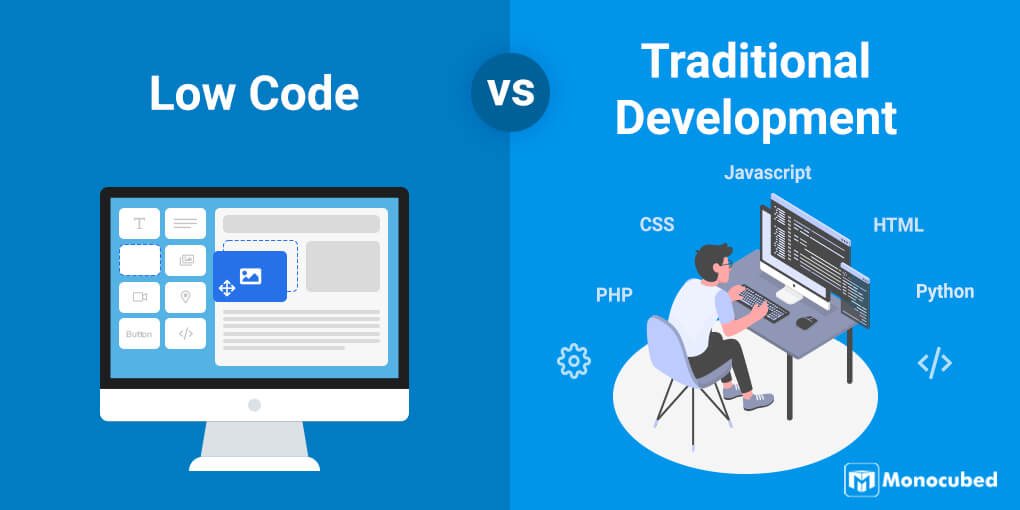Due to several factors due to a variety of factors, low-code development is more accessible to non-developers. They are commonly referred to as "citizens developers."
Drag-and–Drop Builders : Low-code platforms provide drag-and-drop interfaces that allow non-developers, who do not need to write code, to develop visual applications. This makes the development process easier for those with no technical background.
WYSIWYG editor: The "What you see is the result you get" editors allow users to design interfaces, workflows and other features in a manner that closely mimics the final outcome. They are easier to understand and to make use of.
Simplified Logic Design and Workflow Design
Visual Workflow Modeling: Users are able to develop business procedures, application logic, and flowcharts through models and visual flowcharts. These methods are more intuitive than traditional methods of coding.
Pre-built Components of Logic Low-code platforms typically include already-built logic (e.g. loops, conditional statement) that are easily set up, eliminating the need for complex programming.
Reusable templates and components:
Library of Pre-built Templats: Many Low-Code platforms offer templates that are based off of common application types. Non-developers are able to customize these templates if needed.
Reusable Modules and Widgets: Users can leverage modular and reusable widgets, streamlining the creation process and reducing the requirement for technical knowledge.
Tutorials and guide development:
Step-by-Step instructions: Platforms offer instructions and help on screen to non-developers who are building applications.
Interactive Tutorials Interactive tutorials are interactive and hands-on that allow users to learn through doing. This boosts their confidence in the platform.
Integration with Tools Already in Use:
Seamless Integration: Low-code platform are designed to seamlessly integrate with the existing business tools, systems, and software (e.g. ERP or CRM). This enables non-developers who do not have a background in programming to build applications that can work with their existing workflows.
APIs Connectors: APIs are built into applications to simplify integration. This allows non-programmers, who don't have programming abilities, to connect to external services.
Collaboration Features:
Team Collaboration: real-time collaboration, shared workspaces and shared workspaces allow business analysts, non-developers, and other stakeholders to effectively work alongside professional developers.
Access Control Based On Roles: Users who do not develop are able to be assigned roles and access levels that permit users to contribute, without compromising security or functionality.
Automated testing and debugging
Low-code platforms come with tools to test and debug that are built-in. They automatize the process so it is easier for nondevelopers to ensure their apps run.
Platform identifies errors as they occur and offers fixes. This assists non-developers in problems.
Overall, the benefit of low-code development for accessibility to non-developers is in its ability to democratize the development process. Low-code applications allow business users to be involved in the creation and maintenance of apps by offering visual tools as well as a guiding experience. This is a bridge between business and technical needs. Check out the best Low-code Platform for application development url for site examples including developing mobile apps, cross platform mobile dev, push notifications, build a docker container, develop mobile application, develop mobile application, cross platform mobile dev, push notifications android, low code development platforms, push notifications android and more.

Low-Code Development's Cost-Effectiveness Is One Of The Main Benefits.
The low-code approach to application development is a cost-effective solution with many benefits. It's a fantastic option for companies looking to maximize their budgets as well as create top-quality applications. Here are a few of the main benefits:
Lower Coding Requirement: Lower coding platforms eliminate the requirement to code manually, saving developers both time and money. This results in lower labor costs.
Fewer Developers: Because low code development is faster and simpler and less complex, there are fewer resources for developers required. This will drastically lower the cost of hiring and staffing.
Speedier Time to Market
Accelerated Cycle of Development: Visual tools that are low-code and components facilitate rapid development of applications. This allows businesses to launch products faster. This may result in quicker revenue generation, and improved positioning in the market.
Rapid prototyping: By creating and testing prototypes quickly, businesses can reduce the time they devote to the process of development and allow for quicker iterations on the basis of user feedback.
Reduced Maintenance Costs
The modular design and standard components of apps developed using low-code platforms make them easier to maintain. Maintenance and support costs are cut.
Automated Updates. Many low-code platforms manage updates and patches automatically. Applications are secure and safe without needing extensive manual input.
Efficient Resource Utilization:
Low-code platforms enable business users and other non-developers to be part of the development process. This democratization in development allows businesses and employees to work together, thus reducing the dependency on high-paid developers.
Optimized IT Resource Use IT departments will be able to focus on strategic initiatives instead of getting bogged down by routine tasks of development. This will improve overall productivity and efficiency.
Modular Pricing Models that Scale:
Subscription pricing: A lot of low-code platforms offer flexible pricing plans for subscriptions that can be scaled according to usage. This lets businesses match their spending to their actual needs and increase.
Pay-As You-Go: Some platforms offer pay-as you-go options. This lets companies only pay for resources they actually need. This is particularly beneficial for startups and small-sized businesses with limited budgets.
Reduced costs of third-party software:
Built-in Functionalities : Low-code software often comes with built-in functionality and integrations that reduce the need for extra third-party software, tools, and licenses.
Pre-Built Integrations: The availability pre-built intiations with popular services and systems reduces custom development. This saves time as well as money.
Increased ROI:
Increased Return on Investment Accelerating development and lower costs and a quicker speed to market, businesses can achieve an increased ROI on their investment (ROI).
Increased agility: Businesses are able to adapt quickly to changes on the market or in customer demand and this allows them to remain relevant and take advantage of new opportunities.
Train for More for
User-friendly interfaces: Low-code systems provide user-friendly and easy interfaces that reduce the learning curve. They also reduce the need for lengthy training programs.
Accessible Resources: Many platforms that make use of low-code have extensive educational materials, tutorials as well as community support. This means that there is less necessity for formal education, as well as the expenses associated with it.
Collaboration is streamlined:
Enhance Collaboration Tool: The built-in collaboration tool helps improve collaboration and communication between team members. This leads to faster development processes and also reduces the cost of projects.
Unified Development Environment. An unified development platform helps reduce costs and streamline workflows by making it easier to manage multiple tools.
Low-code development is cost-effective since it lowers maintenance and development expenses. It also accelerates time to market and optimizes utilization of resources. Pricing models can be adapted. This combination of factors offers firms significant financial benefits, making Low-code an attractive option for businesses looking to increase their development budgets while still creating strong and adaptable applications. Read the recommended from this source on Enterprise application development with Low-code Platform for blog advice including push notifications android, low code platforms, low code development platforms, driver jdbc, develop mobile application, multiplatform mobile app development, low code platforms, app modernisation, stored sql procedures, application modernisation and more.

The Benefits Of Low-Code Development To Collaborate And Streamline Workflow
Low-code app development is an excellent option for businesses looking to improve team efficiency by streamlining development processes. Here are the top advantages: Improved Collaboration Across Functions:
Unified Development Environment. Low-code platforms let all team members work together in one integrated environment. This includes business analysts, developers and designers as well as stakeholder. This eliminates silos, and improves communication.
Visual Development Tools: The graphic drag-and-drop feature of low-code platforms makes it easier for non-technical team members to participate in the development process, ensuring that the requirements of the business are correctly captured and implemented.
Communication Enhanced
Real-Time collaboration: Many low-code platforms offer real-time communications features, including simultaneous editing and comments. Instant feedback is also accessible. This helps to reduce the amount of time required to exchange information back and forth.
Workspaces shared by teams have the ability to collaborate on shared workspaces in which they edit and discuss project elements. This will ensure that everyone is working towards the same goals and is on the same level.
Workflow management simplified:
Project management tools that are built-in Low-code platforms typically come with project management tools that allow teams to plan, track and oversee their projects. This includes the management of tasks, tracking progress and management of deadlines.
Workflow Automation: Automating repetitive tasks and workflows reduces errors and manual labor and allows teams to focus on more strategic work and enhancing overall efficiency.
Faster Iteration Cycles:
Rapid prototyping. Low-code platforms allow rapid prototyping. This allows feedback to be quickly integrated, and further improvements to be implemented.
Agile Development Support Supporting agile methods lets teams and individuals work in smaller increments. This can also allow you to quickly adjust to changing circumstances.
Accessibility for non-Developers
Citizens Development: Lowcode platforms enable users of business applications (citizen developers), to create, modify, and maintain applications without extensive code knowledge. This eases the workload on IT teams as well as developers, allowing them to respond more quickly to the demands of business.
Training and Onboarding. The simple interfaces of the training tools help new members to be familiar with the system. this improves teamwork.
Centralized Documentation, Knowledge Sharing, and Information Sharing
Documentation is integrated: Low code platforms usually come with the tools needed to create and maintain documentation within the platform, allowing for all project information to be centralized.
Knowledge Repositories Teams can build and maintain repositories of information that contain best practices templates, templates and reuseable elements, which facilitate the sharing of knowledge and reducing duplication.
Consistency Standards, Standardization and Consistency:
Standardized Components. The use of pre-built standard components provides uniformity across all applications. This helps team members understand and work with different parts of projects.
Governance and Compliance - The built-in governance frames ensure that the development of all applications follows organizational standards as well as regulatory requirements. This helps reduce non-compliance risk and assures that applications comply with high-quality standards.
Feedback and Improvement Loops
Integrated Feedback Mechanisms Low-code platforms usually have integrated feedback mechanisms, allowing users to easily provide feedback on applications, which can then be incorporated into the process of development.
Continuous Improvements: The ability for applications to quickly iterate and implement changes based off of feedback, ensuring that they are in tune with the requirements of the user as well as business objectives.
Visualization of Reporting:
Real-time analytics The built-in analytical and reporting tools provide real-time information about the progress of projects, their performance and user interactions. They facilitate data-driven, informed decision-making.
Visual Workflow Mapping Visual tools to map workflows and processes helps teams to understand and improve their workflows, while identifying bottlenecks and areas for improvement.
Low-code application development has many benefits in terms collaboration and workflow. It is able to bring teams from different backgrounds into one place, streamline communications and streamline certain processes. This creates a more flexible, collaborative and efficient environment for development. This eventually leads to better quality applications and better alignment of business goals.
